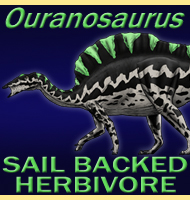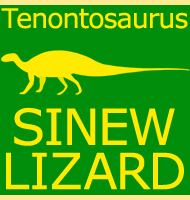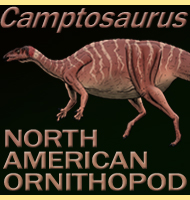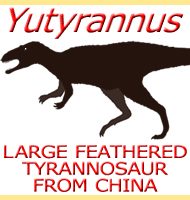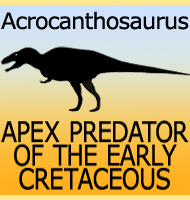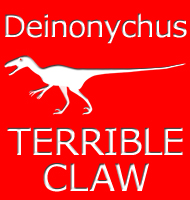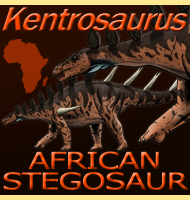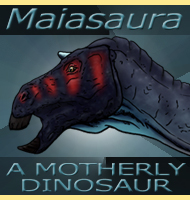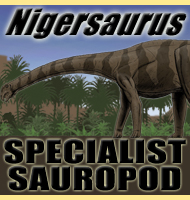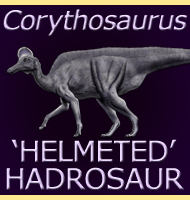


Altirhinus
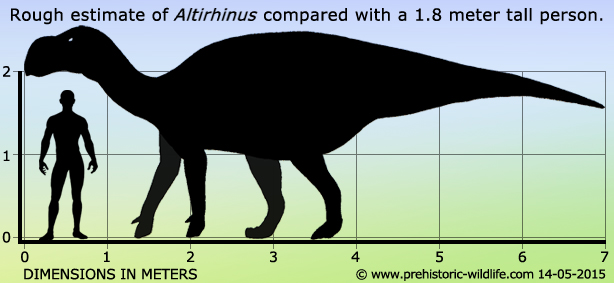
Name:
Altirhinus
(High snout).
Phonetic: Al-te-ry-nus.
Named By: David B. Norman - 1998.
Classification: Chordata, Reptilia, Dinosauria,
Ornithischia, Ornithopoda, Iguanodontia, Hadrosauroidea.
Species: A. kurzanovi
(type).
Diet: Herbivore.
Size: Estimated between 6.5 and 8 meters
long, Skull 76 centimetres long.
Known locations: Mongolia - Dornogovi Province
- Khukhtek Formation (H�hteeg Svita).
Time period: Aptian to Albian of the Cretaceous.
Fossil representation: Partial skull and post
cranial remains from at least five individuals, including two
juveniles.
The
holotype fossils of Altirhinus were originally
classified as a species
of Iguanodon,
I. orientalis back in 1952. However Iguanodon
has
long suffered from the wastebasket taxon effect where remains of
superficially similar dinosaurs have been attributed to the genus, in
part due to its long history and seemingly wide distribution of fossils
being attributed to the genus (in fact Iguanodon
only just missed out
on being the first known Dinosaur by a matter of months, Megalosaurus
was the first to officially be named). New study the type specimens
of I. orientalis in 1996 found that this
species was actually no
different from the main Iguanodon species I.
bernissartensis that was
based upon European material. Another discovery of the time however
was that not all of the fossils previously assigned to I.
orientalis
were a match for Iguanodon, a discovery that led
to the creation of
Altirhinus in 1998 as a new home for these
different fossils. The
type species name of this genus is A. kurzanovi,
and is in honour
of the Russian palaeontologist Sergei Kurzanov.
The
limbs of Altirhinus are interesting as with most
iguanodonts the rear
legs are longer and well developed for supporting the body weight,
while the fore limbs have ‘hands’ that have tightly packed central
digits with bony growths analogous to hooves. This indicates that
Altirhinus was capable of both bipedal (two
legged) and
quadrupedal (four legged) postures, though it is uncertain how
much time Altirhinus, and indeed its relatives,
spent in either
one. Some reconstructions portray iguanodonts as being mostly
bipedal, but dropping to all fours to browse upon low growing
vegetation. Other reconstructions have them as being mostly
quadrupedal but balancing upon their back legs when reaching up to feed
upon higher growing vegetation. Which one is more accurate would
depend upon the actual behaviour of the living dinosaur, which at
this point can only be guessed at. What is more certain is that
Altirhinus and its relatives would have been able to
run on two legs to
try and escape predators, though how long they could maintain this
kind of locomotion is again uncertain.
Altirhinus
seems to have at least been a medium sized ornithopod that might have
grown closer in size to the larger genera of the group. The exact
size is uncertain for now because of the incomplete nature of available
fossils which means that size estimates are based upon comparisons of
more complete genera. This of course depends upon how much like
Altirhinus was to the genera it is being compared
to, and of course
can only give us a rough idea as to the true size.
Studies
of other genera have led to the conclusion that Altirhinus
should be placed
within the Hadrosauroidea
a group of dinosaurs descended from the
Iguanodonts that first came into fruition back in the Jurassic.
Dinosaurs within the Hadrosauroidea would eventually evolve into the
hadrosaurids of the late Cretaceous. Among others, Altirhinus
is
thought to be more advanced than Fukuisaurus
from Japan, but not less
developed than Eolambia
of the USA. Altirhinus
might also be a
relative to Muttaburrasaurus
from Australia due to the striking
similarity in the nasal arch of these two genera.
The
high nasal arch seen in the skull of Altirhinus was
the inspiration for
the genus name which translates to English as ‘high snout’.
Although uncertain due to lack of preservation, this arch might have
existed for a special growth of soft tissue. If true, then this
could have been for anything from visual/audial display, to some
other unknown purpose. Another feature is the strong downward curve
of the front portion of the mouth which might have been an adaptation
to help the incisor teeth crop certain kinds of vegetation. Like with
many other herbivorous animals, there was a toothless gap between the
incisors and the batteries of molar teeth in the posterior portion of
the mouth that is referred to as the diastema. The mouth would work
by cropping plants with the front while also passing them back to be
processed by the rear molars. It is also plausible that as a living
dinosaur, Altirhinus also had cheeks covering the
molar cheeks so
that bits of plant would not fall out of the mouth while being
processed between the teeth.
Further reading
- On Asian ornithopods (Dinosauria: Ornithischia). 3. A new species of
iguanodontid dinosaur. - Zoological Journal of the Linnean Society
122:291-348. - D. B. Norman - 1998.
----------------------------------------------------------------------------
Random favourites
 |
 |
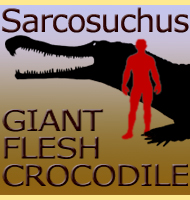 |
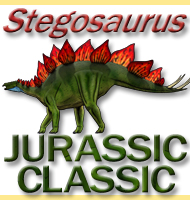 |
